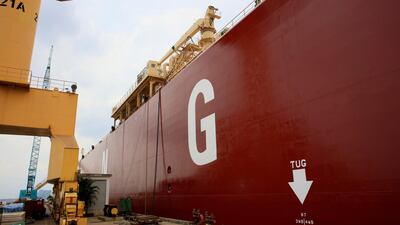“The era of cheap gas is coming to an end,” said Russian President Vladimir Putin in 2008. Now, natural gas is so abundant in parts of Texas that producers have to pay to have it taken away, while prices of liquefied natural gas (LNG) shipments to Asia have plummeted. We are now decisively in the era of cheap gas. Producers and exporters have to adjust to survive and prosper.
The overstuffed market is groaning for relief. Spot LNG cargoes to Asia dipped below $4 (Dh14.7) per million British thermal units (MMBtu) this summer, having been as high as $10 last summer. Futures prices are higher, but are still only $7.6 per MMBtu this coming winter, the high demand period.
Prices in Europe have dropped to a decade-long low, to barely over $3 per MMBtu, and storage in some sites is 95 per cent full.
At the Waha Hub in Texas, the price fell as low as negative $4.28 per MMBtu. Soaring oil production and the gas that comes with it has overburdened pipelines. Even though producers are wastefully burning off much of the excess, some are still paying heavily to dispose of their gas.
This abundance of cheap gas is looking for international markets. A “big four” of LNG producers have emerged. The US only started exporting LNG in February 2016, but is already the world’s fourth-largest seller. Australia will soon become the biggest at about 81 million tonnes annually, overtaking Qatar’s 77 Mt, yet Doha too will expand its capacity to 110 Mt annually by 2024.
Meanwhile Russia, for long the world’s biggest exporter of gas by pipeline, has surfaced as a major LNG player, too. Earlier this month, Kremlin-linked Novatek announced it had approved its Arctic 2 project, following on the surprisingly successful plant on the harsh Yamal peninsula.
This tidal wave of LNG supply has been cheap enough to find ample demand. Gas has pushed coal out of power generation in the US and Europe. New markets, such as Pakistan, Bangladesh, Panama and Bahrain, have emerged, while countries with spare import capacity, such as Turkey, are taking LNG to save on more costly pipeline supplies. Developers propose import terminals of varying reality in almost every European, Asian and African country with a coastline.
China’s demand growth was exceptionally strong in 2017-2018 as it sought to convert dirty coal-fired heating and industry in northern China to gas.
Still, this extra demand has not been enough to sustain prices. In 2019, Beijing’s gas push continued but at a slower rate, while its economy slowed. It is now the world’s largest gas importer and the major hope for future gas consumption. Still, China alone cannot prop up prices. The mature markets of Japan, South Korea and Taiwan are showing little expansion.
The longer-term future for gas seems rosy, encouraging oil companies to shift to being gas majors. With half the carbon dioxide emissions of coal, little release of other pollutants, and less than half the price of oil, it is a versatile and relatively clean fuel.
Unlike oil and coal, gas should still show strong growth into the 2030s and beyond. Yet there is a continuing flood of potential supply: 1,100 Mt per year of possible LNG projects chasing just 125 Mt of annual demand by 2035. Many are in the US, but Canada, recent big finds in north-west Africa (Mauritania-Senegal) and east Africa also contribute.
The Middle East is boosting domestic gas production from its huge resources. Adnoc has announced plans to make the UAE self-sufficient, and even increase exports. Oman’s “tight” unconventional gas from BP’s Khazzan field has satisfied its demand and led it to look for new markets. In November, Saudi Aramco said it plans to spend $150 billion over the next decade to become an exporter of gas. Iran’s completion of long-delayed phases of its South Pars field have largely met its needs at home and allowed it to start exporting to Iraq.
Some large discovered resources are at risk of staying stranded – unable to find a viable way to market, for combined reasons of economics, geography, lack of heavyweight backers, and politics. Big new east Mediterranean fields have saturated the relatively small local markets, but the Turkey-Cyprus and Israel-Palestine disputes block the easiest ways out.
Turkmenistan has the world’s fourth largest gas reserves, more than the whole of Africa. But the landlocked desert country, with fewer than 6 million people, exports significant amounts only to China. Planned routes across Afghanistan to Pakistan and India, or over the Caspian to Azerbaijan, Turkey and Europe, appear firmly barred by nature and politics.
Major gas fields found in Iraq’s Kurdistan region have lain idle despite the 2013 signature of an import agreement with Turkey. Europe’s intended “fourth corridor” of gas imports from the Middle East and Caspian will be difficult to realise while prices at the destination are so low, insufficient to cover the cost of developing fields and building pipelines. Cheap LNG takes the heat off the continent’s quest to diversify from Russian pipes.
New gas needs to drive out coal, complement newly low-cost solar and wind power, and serve new markets. Geographically, south Asia and Africa beckon; in sectors, gas could provide zero-carbon energy by conversion to hydrogen. Just having the resource is not enough anymore: major producers need to invest smartly to create demand, keep their political instincts sharp, and be ruthless and innovative to stay cheap.
Robin M. Mills is CEO of Qamar Energy, and author of The Myth of the Oil Crisis


